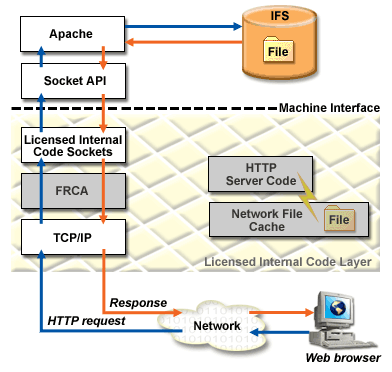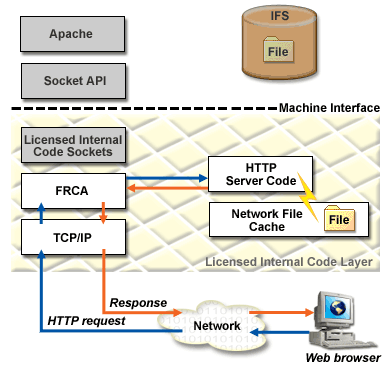Fast Response Cache Accelerator (FRCA) for HTTP Server (powered by Apache)
In the IBM HTTP Server for i5/OS, the Fast Response Cache Accelerator (FRCA) improves the performance and scale of Web and TCP server applications by storing both static and dynamic content in a memory-based cache located in the Licensed Internal Code.
Information for this topic supports the latest PTF levels for HTTP Server for iSeries . IBM recommends that you install the latest PTFs to upgrade to the latest level of the HTTP Server for i5/OS. Some of the topics documented here are not available prior to this update. See IBM Service for more information.
Fast Response Cache Acceleration is only available for V5R2 HTTP Server and later releases.
You can configure FRCA by using the IBM Web Administration for i5/OS interface. See Setting up Fast Response Cache Accelerator (FRCA) for HTTP Server (powered by Apache).
FRCA improves efficiency, scale, and performance by implementing two concepts:
- Use of a memory-based cache that filters what is stored and what is dismissed. Requests can process much more quickly when the majority of the requested content is cached within the Licensed Internal Code. The memory-based cache delegates stored information to the Network File Cache which is located in the Licensed Internal Code.
- Caching functions from within the Licensed Internal Code to reduce request processing time. Storing cached files within the Licensed Internal Code eliminates overhead and reduces request processing time by reducing task-switching between the Licensed Internal Code and user application layers. This conserves system resources allowing them to be reallocated towards hosting dynamic content.
The HTTP Server (powered by Apache) does not check for authorization on content served from FRCA. Use FRCA to cache content that does not need to be secured or accessed through specific validation.
FRCA improves HTTP Server (powered by Apache) performance for both static and dynamic content.
Static content, or content that comes from a file, is stored in Network File Cache and is then served to Licensed Internal Code of HTTP Server (powered by Apache) which essentially 'short circuits' the normal request processing path so the requested information will reach the user faster.
Dynamic content can be served from a Licensed Internal Code proxy cache or distributed by the Licensed Internal Code reverse proxy to one or more remote servers. A layer-7 router looks at the URL paths to route dynamic requests to the appropriate remote server.
Static content request and response process without FRCA

Static content request and response process with FRCA
